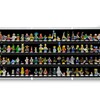Interior Doors: Function, Style, and Practical Design for Every Room
Interior doors play a crucial yet often overlooked role in home and building design. They provide privacy, reduce noise, separate spaces, and enhance the aesthetics of your interiors. Unlike exterior doors, which focus primarily on security and insulation, Interior Door are more versatile in style, lightweight, and designed to complement the room's decor.
In this article, we’ll explore everything you need to know about interior doors, including types, materials, benefits, modern trends, and buying tips.
- The Role of Interior Doors in a Home
Interior doors are much more than simple room dividers—they’re essential elements of both function and design. With the right choice of materials, styles, and finishes, they enhance the atmosphere, improve space utility, and reflect your personality and taste.
Interior doors serve several important functions:
- Privacy: Doors separate private spaces such as bedrooms, bathrooms, and offices from common areas.
- Noise Control: They help reduce sound transmission between rooms.
- Aesthetics: Doors add visual structure and style to interior design.
- Space Management: Doors can divide or open up space as needed.
- Safety and Containment: Interior doors can restrict access to certain areas (e.g., baby gates or pet barriers).
Unlike exterior doors, interior doors do not need to withstand weather elements, allowing for greater material and design flexibility.
- Types of Interior Doors
There are numerous types of interior doors, each with unique applications and styles. Here's an overview of the most common types:
a. Panel Doors
Panel doors feature framed panels that may be raised, recessed, or flat. These classic doors are often used in traditional or transitional interiors.
b. Flush Doors
Flush doors have a smooth surface and are typically made from plywood or MDF over a solid or hollow core. They are minimal, clean, and often used in modern interiors.
c. French Doors
Consisting of two doors with glass panes, French doors are used to allow light between rooms, such as from a dining room to a living room or study.
d. Sliding Doors
Sliding doors save space by gliding along a track rather than swinging open. They’re ideal for closets, bathrooms, or separating small rooms.
e. Pocket Doors
These doors slide into a hidden cavity inside the wall. Pocket doors are excellent for tight spaces like powder rooms or laundry areas.
f. Barn Doors
Mounted on an external track, barn doors slide open and are a popular rustic or industrial style choice for modern homes.
g. Bifold Doors
Often used for closets or utility rooms, bifold doors consist of two panels that fold against each other when opened.
h. Accordion Doors
Flexible, folding doors made of vinyl or lightweight materials. These are less common but used for space dividers or utility areas.
3. Materials Used in Interior Doors
The choice of material impacts the door’s look, weight, durability, and cost. Common materials include:
a. Solid Wood
- Durable and offers a premium look
- Great sound insulation
- Can be expensive
- Ideal for main rooms and master bedrooms
b. Hollow Core
- Lightweight and affordable
- Made with a wood frame and cardboard or foam core
- Suitable for closets and rooms with low traffic
- Poor sound insulation
c. Solid Core
- Engineered wood or MDF core with wood veneer
- Heavier and better sound insulation than hollow core
- Good balance between cost and performance
d. MDF (Medium Density Fiberboard)
- Smooth, flat surface ideal for painting
- Doesn’t warp or crack like solid wood
- Often used in flush or molded panel doors
e. Glass
- Often combined with wood or metal frames
- Allows light flow between rooms
- Used in French doors, sliding doors, or as design accents
f. PVC or Vinyl
- Lightweight and moisture resistant
- Used in bathrooms or utility areas
- Less premium look
4. Choosing the Right Interior Door
When selecting interior doors, consider the following:
a. Functionality
What is the purpose of the room? Bedrooms need privacy and sound insulation. Closets need light access and space-saving features. Bathrooms require moisture resistance.
b. Style
Choose a style that complements your interior decor. For traditional spaces, paneled doors or French doors are appropriate. Flush and minimalist doors work well in modern interiors.
c. Swing Direction
Determine whether the door should swing in or out, and on which side the hinges will be installed (left-hand or right-hand).
d. Size
Standard interior door sizes are usually 80 inches high and 24-36 inches wide, but custom sizing is available.
e. Budget
Hollow-core doors are the most affordable, while solid wood and custom designs cost more.
5. Interior Door Hardware and Finishing
The hardware you choose enhances functionality and style:
- Handles and Knobs: Available in a range of styles from antique brass to sleek chrome.
- Hinges: Should match the finish of your hardware.
- Locks: Privacy locks for bathrooms and bedrooms; passage handles for hallways; dummy knobs for closets.
- Trims and Casings: Add a finished look and can match or contrast with the door design.
Finishing options include:
- Paint: Choose a color that complements the room or creates a statement.
- Stain: Highlight the natural wood grain.
- Lacquer or Varnish: Protects the surface and adds a sheen.
6. Modern Trends in Interior Doors
Interior door trends evolve with design styles and homeowner preferences. Current popular trends include:
a. Minimalist Flush Doors
Seamless doors with hidden frames or no trim are popular in modern and contemporary homes.
b. Black or Bold-Colored Doors
Statement doors in black, navy, or bold hues contrast sharply with white or neutral walls.
c. Glass and Metal Combinations
Industrial-style glass doors with black metal frames are widely used in loft-style apartments and offices.
d. Sustainable Materials
Eco-conscious homeowners are choosing doors made from recycled wood, bamboo, or FSC-certified materials.
e. Textured or Carved Surfaces
Adding a tactile feel, these doors offer visual interest even in neutral colors.
7. Maintenance and Care Tips
Interior doors generally require less maintenance than exterior ones, but regular care ensures longevity:
- Dusting and Cleaning: Use a damp cloth and mild cleaner to wipe surfaces.
- Avoid Excess Moisture: Especially important for wood or MDF doors in bathrooms.
- Lubricate Hinges: Prevents squeaking and ensures smooth operation.
- Repaint or Restain: As needed to maintain a fresh look or change decor.
8. Installation Considerations
Installing an interior door can be DIY-friendly, especially for pre-hung units. However, consider these points:
- Frame Condition: Ensure the door frame is square and level.
- Wall Type: Installing pocket doors requires modifying the wall structure.
- Professional Help: Consider hiring a carpenter or contractor for custom or large-scale door projects.
Conclusion
Interior doors are much more than simple room dividers—they’re essential elements of both function and design. With the right choice of materials, styles, and finishes, they enhance the atmosphere, improve space utility, and reflect your personality and taste.
Whether you're renovating, building, or simply upgrading a room, investing in quality interior doors is a decision that brings value, comfort, and beauty to your home.



